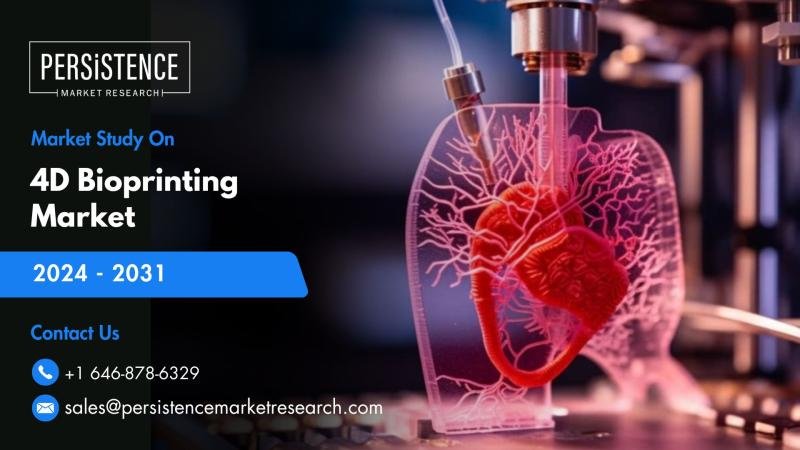The 4D bioprinting market is gaining momentum as it holds the potential to transform healthcare, tissue engineering, and a variety of other industries. Unlike traditional 3D printing, 4D bioprinting introduces the additional dimension of time, allowing printed structures to change shape or behavior over time in response to external stimuli. This dynamic process could revolutionize fields like regenerative medicine, drug testing, and organ transplantation. The market, which is expected to grow at a compounded annual growth rate (CAGR) of 30.4%, is projected to expand from an estimated value of $90 million in 2024 to a significant $579.6 million by 2031. This dramatic rise in market valuation is driven by technological advancements, increased investments in research, and the growing demand for innovative healthcare solutions.
Get a Sample PDF Brochure of the Report (Use Corporate Email ID for a Quick Response): www.persistencemarketresearch.com/samples/34109
The 4D bioprinting market is at a pivotal juncture, with immense potential in biomedical applications. The technology involves printing bio-inks or living cells that can alter their shape or function in response to stimuli such as temperature, moisture, or light. These changes could be pivotal for creating dynamic structures like self-healing tissues or organs, making it a significant advancement over traditional 3D bioprinting. The global market is expected to witness rapid growth driven by increasing healthcare demands, advancements in material science, and rising awareness of personalized medicine. The leading segment within the 4D bioprinting market is anticipated to be the healthcare sector, which includes applications in regenerative medicine and tissue engineering.
Geographically, North America is forecasted to dominate the 4D bioprinting market, primarily due to the region’s advanced healthcare infrastructure, high investments in bioprinting technology, and leading research initiatives. The U.S., in particular, is a hub for bioprinting innovations, with major companies and research institutions contributing significantly to the market’s growth. Europe is also witnessing substantial advancements in bioprinting, while the Asia-Pacific region is expected to emerge as a promising market as more countries invest in healthcare innovation and technology.
Key Highlights from the Report:
• The global 4D bioprinting market is expected to grow at a CAGR of 30.4%.
• The market size is forecast to increase from $90 million in 2024 to $579.6 million by 2031.
• North America is projected to dominate the market due to its advanced healthcare infrastructure.
• Healthcare is the leading segment, driven by applications in regenerative medicine and tissue engineering.
• The market is witnessing increased investment in R&D and technological advancements.
• Governments and private sectors are focusing on the commercialization of 4D bioprinting technologies.
Market Segmentation
The 4D bioprinting market can be segmented based on product type, end-user, and other relevant categories. By product type, the market is divided into bio-inks, printers, and other supporting materials. Bio-inks, particularly those that incorporate living cells and materials that can change shape over time, are crucial to the success of 4D bioprinting applications. The printer segment also plays a vital role in the adoption of 4D bioprinting technologies, with continuous advancements leading to more efficient and precise printing capabilities.
In terms of end-users, the market is primarily divided into healthcare, research, and industrial applications. The healthcare sector is driving much of the market growth, particularly in the fields of regenerative medicine, drug development, and tissue engineering. Research institutions are also key players, focusing on the development of new bioprinting materials and techniques. Industrial applications, while still in the early stages, hold potential for mass production of customized medical devices or tissue-based products in the future.
Regional Insights
North America holds the largest share of the global 4D bioprinting market. The region is home to leading bioprinting companies and research institutions, making it a hub for innovation and commercialization. The United States is investing heavily in research and development, and the market is expected to continue expanding in response to technological advancements and regulatory support.
Europe is also witnessing a significant rise in 4D bioprinting activities. Countries like Germany, the UK, and Switzerland are prominent players in the European bioprinting market, with increasing focus on regenerative medicine, tissue engineering, and drug testing. The region benefits from strong collaborations between academic institutions, government organizations, and industry players, fostering an environment conducive to market growth.
Market Drivers
The market for 4D bioprinting is largely driven by advancements in bioprinting technologies and the increasing demand for personalized medicine. As healthcare systems globally evolve, there is a rising need for customized solutions, such as bio-printed tissues and organs. The growing focus on regenerative medicine and the ability to print living tissues that can respond to environmental changes make 4D bioprinting a powerful tool in this space. The continuous development of new bioprinting materials and techniques further supports this growth, enabling more complex and functional structures to be created.
Additionally, the increasing prevalence of chronic diseases and the need for advanced treatment options are fueling demand for innovative medical technologies. 4D bioprinting is poised to provide solutions that go beyond the limitations of traditional treatments, offering more effective and personalized healthcare options.
Market Restraints
Despite its promising potential, the 4D bioprinting market faces several challenges. One of the primary restraints is the high cost associated with the technology. The development of 4D bioprinting printers and the materials required for printing living tissues can be prohibitively expensive, limiting the accessibility of the technology to a wider audience. Additionally, regulatory hurdles around the use of living cells in bioprinting and the commercialization of bioprinted organs may slow down adoption.
Another significant restraint is the technical complexity involved in printing functional tissues that can mimic the properties of natural organs. Although significant progress has been made, creating bioprinted tissues that can fully replicate the functions of human tissues remains a significant challenge. These limitations may delay the widespread use of 4D bioprinting in clinical and commercial applications.
Market Opportunities
The 4D bioprinting market presents a wealth of opportunities, particularly in the field of regenerative medicine. The ability to print dynamic tissues and organs that can adapt to changes over time opens new possibilities for treating patients with organ failure or chronic diseases. Another opportunity lies in the pharmaceutical industry, where 4D bioprinting could be used for drug testing and personalized drug development, offering more accurate and reliable results.
Furthermore, the growing focus on sustainability and eco-friendly solutions offers an opportunity for 4D bioprinting to contribute to more sustainable healthcare practices. The use of biodegradable or renewable materials in 4D bioprinting processes could reduce the environmental impact of traditional manufacturing methods. As the technology evolves, its application in creating custom medical devices and implants is also expected to expand, offering tailored solutions to meet individual patient needs.
Frequently Asked Questions (FAQs)
• How Big is the 4D Bioprinting Market?
• Who are the Key Players in the Global Market for 4D Bioprinting?
• What is the Projected Growth Rate of the 4D Bioprinting Market?
• What is the Market Forecast for 4D Bioprinting by 2032?
• Which Region is Estimated to Dominate the 4D Bioprinting Industry through the Forecast Period?
Company Insights
Some of the leading players in the 4D bioprinting market include:
• Stratasys Ltd.
• Organovo, Inc.
• 3D Systems Corporation
• EnvisionTEC, Inc.
• CELLINK
Recent Developments:
1. In 2024, Stratasys launched a new line of 4D bioprinters, offering enhanced printing speeds and precision for regenerative medicine applications.
2. Organovo recently partnered with a major pharmaceutical company to develop 4D bioprinted tissues for advanced drug testing and personalized medicine.
The 4D bioprinting market is poised to revolutionize the healthcare and manufacturing industries, offering a wide range of applications that could greatly impact the future of medicine, sustainability, and beyond. As technological advancements continue to push the boundaries of possibility, the market is expected to experience exponential growth, creating new opportunities for innovators, healthcare providers, and investors alike.
Contact Us:
Persistence Market Research
G04 Golden Mile House, Clayponds Lane
Brentford, London, TW8 0GU UK
USA Phone: +1 646-878-6329
UK Phone: +44 203-837-5656
Email: sales@persistencemarketresearch.com
Web: https://www.persistencemarketresearch.com
About Persistence Market Research:
At Persistence Market Research, we specialize in creating research studies that serve as strategic tools for driving business growth. Established as a proprietary firm in 2012, we have evolved into a registered company in England and Wales in 2023 under the name Persistence Research & Consultancy Services Ltd. With a solid foundation, we have completed over 3600 custom and syndicate market research projects, and delivered more than 2700 projects for other leading market research companies’ clients.
Our approach combines traditional market research methods with modern tools to offer comprehensive research solutions. With a decade of experience, we pride ourselves on deriving actionable insights from data to help businesses stay ahead of the competition. Our client base spans multinational corporations, leading consulting firms, investment funds, and government departments. A significant portion of our sales comes from repeat clients, a testament to the value and trust we’ve built over the years.
This release was published on openPR.












